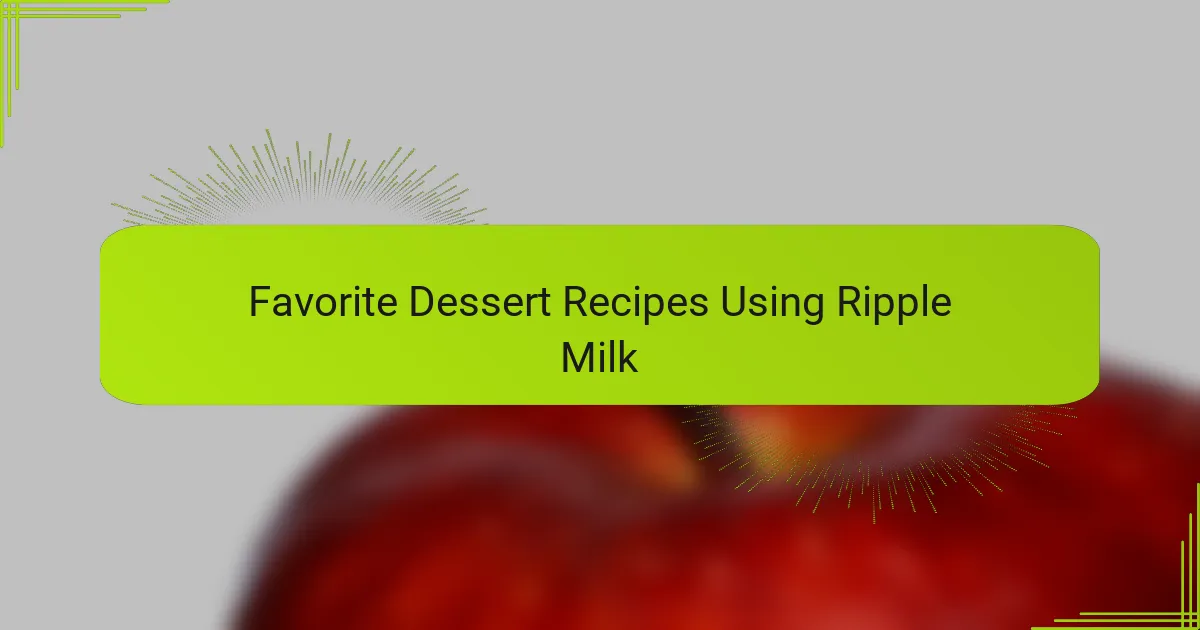Key takeaways
- Ripple Foods Milk, made from peas, offers a creamy texture and neutral flavor that seamlessly substitutes traditional dairy in baking.
- This milk enhances moisture and richness in baked goods without altering their taste, making it a versatile option for desserts.
- Ripple milk contributes to a more sustainable baking experience, allowing bakers to feel good about their ingredient choices while maintaining quality.
- Key tips for using Ripple include treating it like dairy milk, using it at room temperature, and adjusting liquid amounts if necessary for optimal texture.

Understanding Ripple Foods Milk
Ripple Foods Milk caught my attention because it’s made from peas, which sounded unusual at first. I wondered, how does something so different compare to traditional dairy or other plant-based milks in baking? It turns out, its creamy texture and neutral flavor make it a surprisingly versatile choice.
From my experience, Ripple’s milk offers a smoothness that almost mimics cow’s milk, which I found comforting when trying it in recipes that rely on milk’s moisture and richness. Have you ever struggled to find a non-dairy milk that doesn’t alter the taste of your baked goods? Ripple helped me solve that puzzle.
What really intrigued me was how Ripple Foods focuses on sustainability without sacrificing quality. Knowing that the milk is made from peas grown with less water and fewer resources made my baking feel a little kinder to the planet—something I hadn’t considered before. Don’t you think that adds an extra layer of satisfaction to every bite?

Benefits of Ripple Milk in Baking
What I found most helpful about Ripple milk in baking is its ability to create moist, tender textures without any weird aftertaste. When I swapped it for regular milk in my favorite chocolate cake recipe, the result was just as rich and comforting, if not more so. Have you ever been disappointed by plant milks that make your desserts taste off? Ripple milk ended that frustration for me.
Another benefit that caught my attention was its naturally creamy consistency. It blends effortlessly into batters and doughs, which makes mixing smoother and baking outcomes more predictable. I remember thinking, “This is exactly what I needed,” especially when working on delicate recipes like custards and muffins.
Plus, there’s a feel-good factor knowing I’m using an ingredient that’s gentle on the environment without compromising flavor or texture. Doesn’t that make indulging in sweets a little sweeter? Using Ripple milk has made my baking routine feel more thoughtful and satisfying in ways I hadn’t expected.

Comparing Ripple Milk with Dairy Milk
When I first compared Ripple milk to traditional dairy milk, what stood out was how closely Ripple mimics the creamy richness I’d expect from cow’s milk. The texture felt familiar in my baking, which made swapping it in seamless—no need to worry about drastic changes in moisture or crumb. Have you ever hesitated to replace dairy because you feared ruining the texture? Ripple eased that concern for me.
Flavor-wise, I noticed Ripple’s subtle, neutral taste didn’t overpower or clash with the other ingredients like some plant-based milks can. It kept my recipes balanced, allowing the natural sweetness and flavors of my desserts to shine through. Isn’t it frustrating when a milk alternative leaves an odd aftertaste? Ripple’s gentle profile really won me over in that regard.
One thing I didn’t expect was how Ripple’s pea-based composition felt satisfying beyond flavor and texture—it gave me peace of mind about sustainability without sacrificing quality. Using it felt like making a choice that was both delicious and responsible. Don’t you appreciate when the food you bake aligns with your values? That awareness added a pleasant dimension to my baking experience.

Essential Baking Tips with Ripple Milk
One tip I discovered early on is to treat Ripple milk just like regular dairy milk in your recipes. Since its creamy texture behaves similarly in batters, I didn’t have to adjust liquid amounts, which saved me time and guesswork. Have you ever had to tweak a recipe because your milk alternative didn’t play nice? Ripple spared me that hassle.
I also learned that using Ripple milk at room temperature helps it blend more evenly into doughs and batters. Cold milk can sometimes cause curdling or uneven texture, so warming it slightly made my muffins rise better and my custards silkier. It’s a small step that brought noticeable improvements in my baking results.
Lastly, I was pleasantly surprised that Ripple milk’s neutral flavor allowed other ingredients to shine without competing for attention. When I made a lemon pound cake, the zest and vanilla stood out beautifully, not masked by any aftertaste. Don’t you love when your ingredients harmonize perfectly? Ripple’s milk gave me just that confidence.

Personal Experience Baking with Ripple Milk
Baking with Ripple milk felt surprisingly familiar from the start. I remember mixing it into my pancake batter and noticing how effortlessly it blended, giving a creamy consistency without any strange flavor lurking in the background. Have you ever experienced that awkward moment where your milk substitute changes the whole taste? Ripple didn’t do that to me—it respected the recipe’s original vibe.
One time, I tried Ripple milk in a batch of chocolate chip cookies, and I was genuinely impressed by how soft and tender the cookies turned out. It felt like this little ingredient was quietly doing the heavy lifting, adding moisture and richness without overshadowing the other flavors. Doesn’t it feel great when a simple swap leads to better results rather than compromises?
What I appreciated most, though, was the peace of mind Ripple gave me while baking. Knowing that my favorite treats were made with a sustainable product made each bite a bit more meaningful. Have you noticed how that extra layer of intention can make the experience of dessert even sweeter? For me, Ripple milk turned baking into something both joyful and thoughtful.

Favorite Dessert Recipes Using Ripple Milk
One of my go-to desserts with Ripple milk has been a classic vanilla bean panna cotta. The creamy texture of Ripple really shines here, creating that smooth, custardy feel without any hint of plant-based bitterness. Have you ever tried a dairy-free panna cotta that just doesn’t jiggle right? This one came out perfectly silky and delicate, making it my new favorite indulgence.
Another recipe I experimented with is lemon blueberry muffins. Using Ripple milk added just the right amount of moisture to keep them tender while letting the bright fruit flavors pop. I was honestly surprised at how the milk’s neutral taste allowed the zest and berries to really take center stage without competing with any off-flavors. Doesn’t that make all the difference in a fresh, vibrant dessert?
And then there’s the old standby — chocolate chip cookies. That familiar comfort of soft, chewy cookies felt totally achievable with Ripple milk. I think the creaminess helped the dough come together beautifully, resulting in cookies that were both rich and light. Have you found that non-dairy milks sometimes dry out your cookies? Ripple milk definitely turned that expectation upside down for me.

Troubleshooting Baking with Ripple Milk
When I first baked with Ripple milk, I noticed my batter looked a bit thinner than usual. At first, I worried this might affect the texture, but a small adjustment—just a tablespoon less liquid—helped me regain that perfect consistency. Have you ever had to tweak a recipe slightly to get it just right? It’s small changes like these that make all the difference when working with new ingredients.
Sometimes, Ripple milk can cause baked goods to brown faster, especially in recipes with sugar. I learned to lower the oven temperature slightly or shorten the baking time to avoid over-browning. It felt like decoding a little baking puzzle, but the results were worth the extra attention. Doesn’t troubleshooting like this make you feel more connected to the process?
One surprising hiccup I ran into was when using Ripple milk in custards—they didn’t always set as firmly as with dairy milk. I found that gently warming the milk before mixing helped improve the texture. Have you experienced a similar issue with plant-based milks? From my experience, a little patience and experimentation can turn these challenges into satisfying wins.




